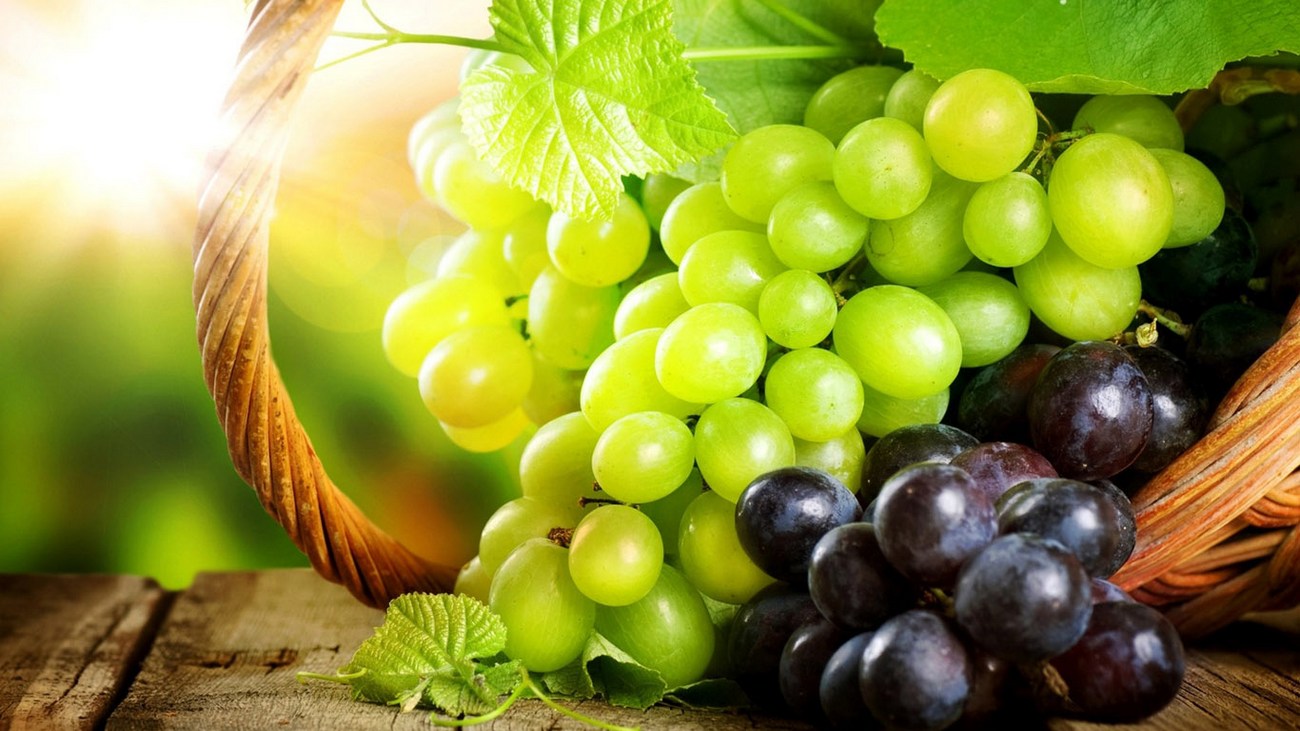 We owe the appearance of new grape varieties not only to scientific institutes and stations, but also to amateur breeders. One of these is Evgeny Georgievich Pavlovsky, thanks to whose work dozens of interesting viable grape hybrid forms have been bred. The best hybrids of the master’s collection have been evaluated and marked at numerous international and Russian exhibitions. At the same time, Evgeny Georgievich does not stop at the milestones reached, continuing the painstaking work of breeding and selecting the best varieties.
We owe the appearance of new grape varieties not only to scientific institutes and stations, but also to amateur breeders. One of these is Evgeny Georgievich Pavlovsky, thanks to whose work dozens of interesting viable grape hybrid forms have been bred. The best hybrids of the master’s collection have been evaluated and marked at numerous international and Russian exhibitions. At the same time, Evgeny Georgievich does not stop at the milestones reached, continuing the painstaking work of breeding and selecting the best varieties.
Content
- 1 Breeder enthusiast
- 2 Breeder's Care Recommendations
- 3 Optimal care conditions
- 4 How to choose cuttings for planting
- 5 Features of Pavlovsky hybrids
- 5.1 Grape variety Ali Baba
- 5.2 Aramis
- 5.3 Aster
- 5.4 Baikonur
- 5.5 Break
- 5.6 Hermann
- 5.7 Gesha
- 5.8 Johnny
- 5.9 Dawn of Light
- 5.10 Marshmallows
- 5.11 Ayuta
- 5.12 Ozone
- 5.13 Romeo
- 5.14 Hummingbird
- 5.15 Beautiful girl
- 5.16 Lelik
- 5.17 Marlborough
- 5.18 Master
- 5.19 Maestro
- 5.20 Monarch
- 5.21 Modern
- 5.22 Muscat Novoshakhtinsky
- 5.23 In memory of the surgeon
- 5.24 In memory of the teacher
- 5.25 Patrick
- 5.26 Beauty
- 5.27 Producer
- 5.28 Rose Not Light
- 5.29 Senator
- 5.30 Senya
- 5.31 Super Extra
- 5.32 Pharaoh
- 5.33 Farm
- 5.34 Charley
- 5.35 Enigma
- 5.36 Effect
- 5.37 Anniversary 50
- 5.38 Jaguar
- 5.39 Juliet
- 5.40 Carmen
- 5.41 Rochefort
- 5.42 Hip-hop
- 6 Reviews
Breeder enthusiast
 It so happens that your favorite hobby grows into a life-long affair, a vivid example of this is the breeder Pavlovsky. He worked as a miner in his spare time growing grapes, and then seriously became interested in breeding new varieties of culture.
It so happens that your favorite hobby grows into a life-long affair, a vivid example of this is the breeder Pavlovsky. He worked as a miner in his spare time growing grapes, and then seriously became interested in breeding new varieties of culture.
Fulfilled the tasks of employees of VNIIViV them. Ya. I. Potapenko (Novocherkassk), experimented with vaccination methods, grew industrial lots of varieties.
Thanks to the work of an amateur gardener, fruitful hybrid forms were born, tests of many varieties were carried out. The Pavlovsky grapes have been heard by wine growers from different regions; a number of varieties are successfully grown in the middle lane, in Siberia, regions of the Urals, and Karelia.
Breeder's Care Recommendations
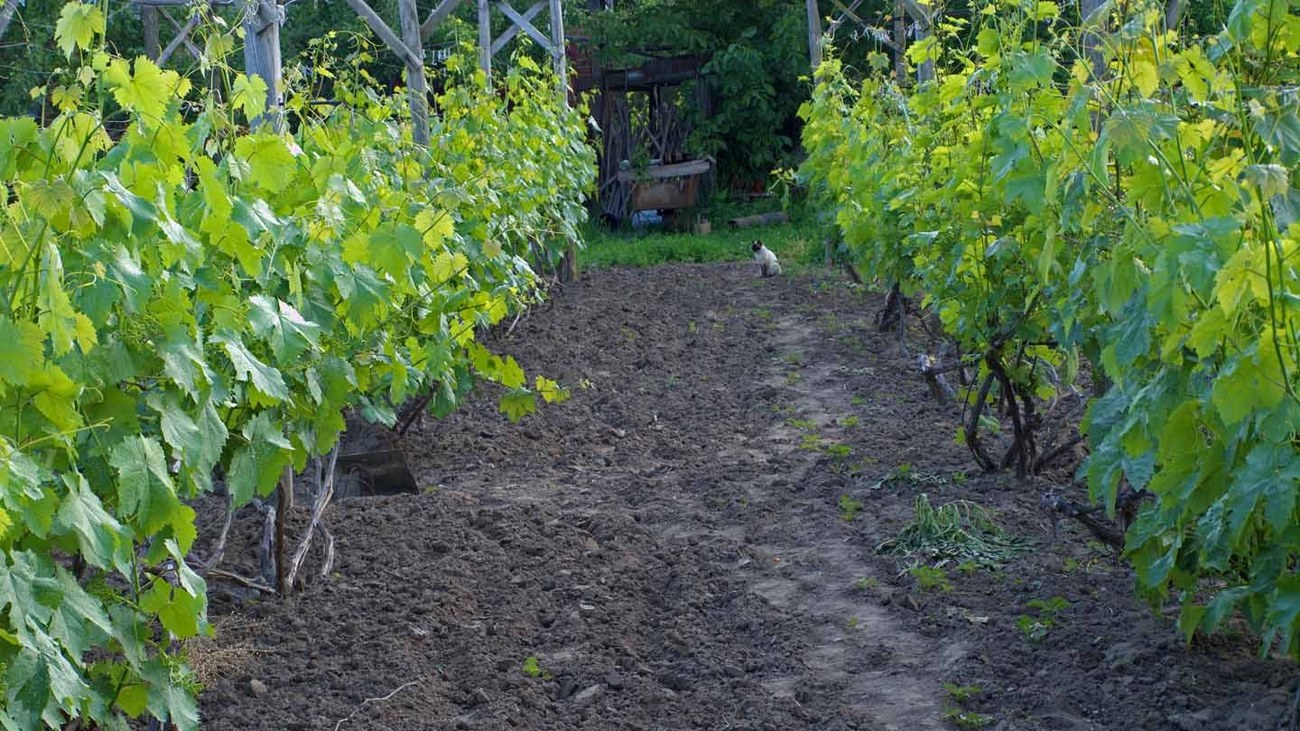 It is recommended to buy seedlings in specialized nurseries, nurseries, before that, having studied the characteristics of the species. The gardener notes that there are no special requirements for soil, irrigation volumes, fertilizing during cultivation of hybrid forms. Agricultural Techniques standard:
It is recommended to buy seedlings in specialized nurseries, nurseries, before that, having studied the characteristics of the species. The gardener notes that there are no special requirements for soil, irrigation volumes, fertilizing during cultivation of hybrid forms. Agricultural Techniques standard:
- planting seedlings in spring and autumn;
- selection of a fertile, well-closed area from the winds;
- compliance with the rotation of crops on the site.
After uprooting the old bushes, the earth is given rest. New grape seedlings are planted no earlier than in 2-3 years.
Optimal care conditions
The culture requires sufficient water during irrigation, does not tolerate excess moisture. Loosen the soil, mulch the surface between the bushes with sawdust, humus.
Sawdust suitable rotted, blackened. Layer of mulch - 3-4 cm.
In top dressing, they combine “chemistry” and organics, introducing fertilizers at the norm. Effective use of humus, improving the structure of the soil, permeability. In the spring feeding of hybrids, nitrogen prevails, in the summer the bushes are fed with potash, phosphorus compounds.
When pruning, growth points on young shoots are removed, bushes are formed and thinned. When shading clusters, interfering leaves break off.
In the spring, plantings against pests are sprayed (for prophylaxis). In the summer season treatments continue using Topaz, Quadrice, Bordeaux.
Pavlovsky's grape hybrids are cold-resistant types of culture. When cultivated in the south, plants do not cover, in areas with a cold climate protection is required. They bend the vine, cover it with a film, non-woven materials, leaving air space inside the shelters. For young seedlings they use tubs, plastic containers that are covered with soil from above.
How to choose cuttings for planting
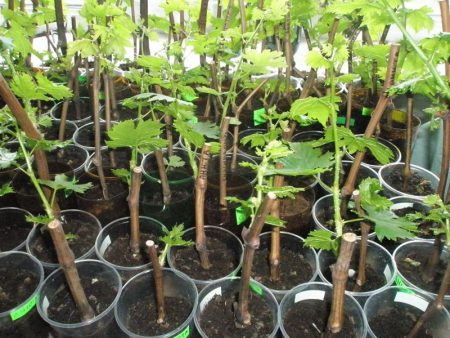 Grape growers with experience are selected planting material on the site, choosing the highest quality bushes for cuttings. When buying seedlings, pay attention to the following signs:
Grape growers with experience are selected planting material on the site, choosing the highest quality bushes for cuttings. When buying seedlings, pay attention to the following signs:
- the presence of 3-4 thick roots;
- vine with 3-5 buds;
- the kidneys should be “alive” (with a light touch of a finger they do not fall off from the shoot);
- the total length of the handle is at least 30-40 cm.
Before planting, seedlings with roots are placed in melt water for a day. To improve the survival rate, a stimulant is added to the water: Kornevin, heteroauxin.
Features of Pavlovsky hybrids
The gardener has bred more than five dozen hybrid forms, most of them highly appreciated by winegrowers. There are not entirely successful options, but this is common to all research and experiments.
Pavlovsky's main focus is on type inference, disease resistant, productive, unpretentious. Hybrids are characterized by frost resistance, excellent taste of berries. Gardeners highlight their resistance to fungal, viral infections, which is important for such a capricious culture like grapes.
Work on improving hybrids is ongoing; annually Evgeny Georgievich presents new products. But there are those that have successfully established themselves, grown in areas of gardeners.
Grape variety Ali Baba
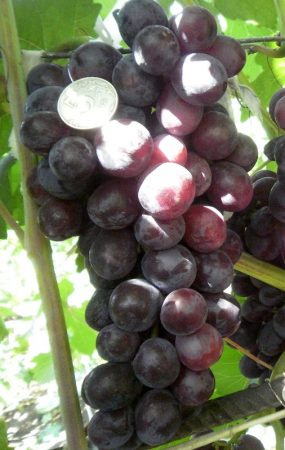 The hybrid form (gf) is distinguished by early (100 days) maturation of shoots, increased resistance to fungal infections. Large clusters with oval, dark red berries form on vigorous bushes. The pulp is dense, fleshy.
The hybrid form (gf) is distinguished by early (100 days) maturation of shoots, increased resistance to fungal infections. Large clusters with oval, dark red berries form on vigorous bushes. The pulp is dense, fleshy.
Advantages:
- harmonious taste;
- no peeling;
- frost resistance up to -23ºC;
- good pollination.
Cut the shoots 4-6 eyes, root without any difficulty. At Ali Baba, young shoots bear fruit, clusters of them ripen later than the main ones. To obtain a high quality crop, it is recommended to remove the shoots.
The berries stay on the vine for a long time, do not fall, retain their taste. Of the disadvantages, a high density of the grones is noted, which interferes with the formation of the form.
Aramis
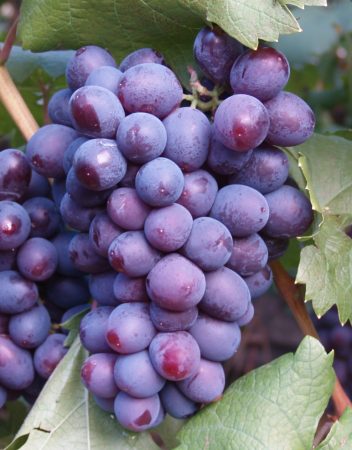 In the group of table varieties, g. Aramis with beautiful and appetizing looking berries. Plants are vigorous, pruning vines - 5-8 buds.
In the group of table varieties, g. Aramis with beautiful and appetizing looking berries. Plants are vigorous, pruning vines - 5-8 buds.
Obtained from crossing a mixture of pollen from different varietal species with Cardinal and Talisman grapes. Pollination is good, peduncles are bisexual. The first berries are picked in early August, in terms of 100-110 days. Dates are given for the southern regions of Russia.
Maturation occurs along the entire length of the vine; fruiting of stepsons is possible. It withstands loads, but crop rationing is recommended. Berries weighing 100 grams, oval, inside - dense. Color - purple with a red tint, the skin is durable, not rough.
The taste is pleasant, when fully ripened, musky notes are noticeable.
Aramis is resistant to cold (can withstand up to -23ºC), is not susceptible to rot. Suitable for transportation, which is important for growing grapes for sale.
Aster
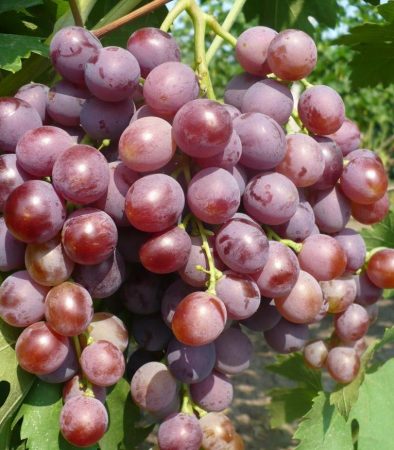 The Astra hybrid boasts good pollination and high productivity. The production period is 130 days, in the southern regions it matures by August 20.
The Astra hybrid boasts good pollination and high productivity. The production period is 130 days, in the southern regions it matures by August 20.
Bushes are powerful, the vine ripens well. Leaves with weak dissection; there is no pubescence on the underside. The degree of frost resistance reaches -24ºC, according to the main characteristics, additional tests are required.
Conical grones are dense, not loose. The berries are large, resembling an oval, covered with dark red skin. The pulp is juicy, pleasant grape flavor. The weight of the grones is about 600 grams, the berries reach a weight of 8 grams (some specimens 13-15 grams).
Moderately affected by major diseases of the culture (oidium, mildew), the hybrid is slightly affected by pests. Propagation by rootstocks, own seedlings. Quick cleaning is not required, the berries do not fall off. Maturation occurs at a time, which is convenient for harvesting.
Disadvantages: the frequency of berry formation (no stability). Usually a high yield from Astra is harvested after a year, which is explained by the characteristics of genetics.
Baikonur
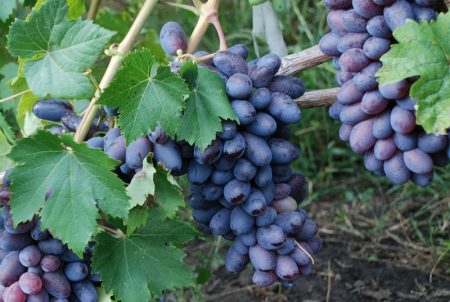 Sweetness and excellent aroma - The visiting card of the hybrid form Baikonur. Refers to table species, fruits are harvested after 112-115 days (early ripe variety).
Sweetness and excellent aroma - The visiting card of the hybrid form Baikonur. Refers to table species, fruits are harvested after 112-115 days (early ripe variety).
The best qualities are transmitted from parents - grapes Beauty and Talisman. Cultivated since 2012, received a lot of praise.
The weight of the bunch is 600-700 grams, the berries are cylindrical in shape, by weight - from 13 to 18 grams. The skin is tender, inside there is a dense juicy pulp, 2-3 small bones. The taste is pleasant, without the presence of nutmeg shades. Sugar content in fruits - 20%.
Fruits abundantly, the distribution of shoots is uniform. Mandatory rationing of the brushes on the shoots is required, otherwise they will break under the weight of the crop. Not prone to burning, not prone to rot, fungal infections.
A new hybrid, is being tested, the optimal planting scheme, soil composition, reaction to changing weather conditions are being determined.
Break
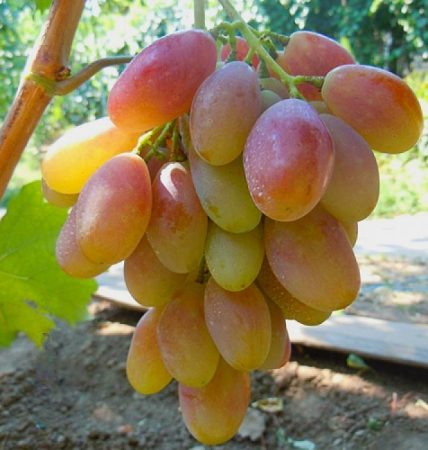 Bushes of the city of F. stand out with great strength and power. Break Obtained after crossing grapes Zagrava and Golden Don. Peduncles bisexual, a high degree of maturation of fruitful shoots.
Bushes of the city of F. stand out with great strength and power. Break Obtained after crossing grapes Zagrava and Golden Don. Peduncles bisexual, a high degree of maturation of fruitful shoots.
The clusters are large (600 grams), elegant, with elongated oval berries. Weight - 14-15 grams. Due to the original shape of the fruit, the brushes look unusual and attractive.
Color is dark pink. The flesh is slightly crisp, with a pleasant harmonious taste. Resistance to diseases is average, withstands frosts down to -21ºC. Harvested from August 25.
Hermann
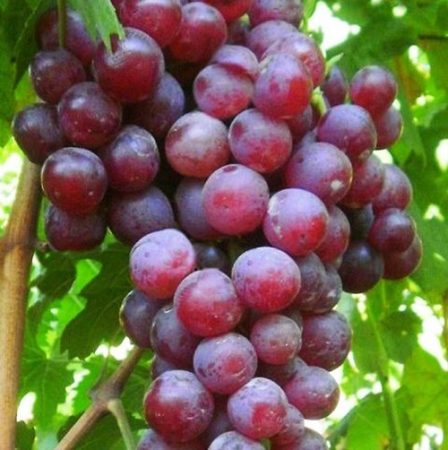 Original, as if shrouded in a light haze, Herman's berries attract attention. Shoots are high, up to 3 meters or more, with neat clusters.
Original, as if shrouded in a light haze, Herman's berries attract attention. Shoots are high, up to 3 meters or more, with neat clusters.
Peduncles self-pollinated, bisexual, which simplifies care. Fruits with juicy pulp, dense shell, weighing 10-12 grams. The taste is pleasant, a sweet aroma is felt.
The weight of the grones reaches 1.5 kg, the density is average. The color of the berries varies, from dark purple to plum and brown. The taste is not lost, even if the berries remain on the vine for a long time - this is a “plus”, the study continues with respect to other parameters. Frost resistance is high, minus 24ºC withstands, but shelter is required. Harvested in August (south), in the middle lane - early September.
Gesha
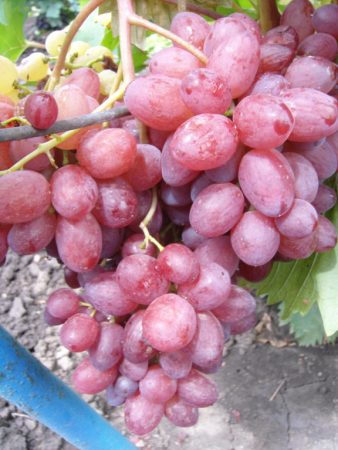 Approximately 110 days are required to wait for the first berries of the Gesha hybrid. A little-known form of grape obtained from the crossing of T. Hadzhibey and Sprinter with the Talisman.
Approximately 110 days are required to wait for the first berries of the Gesha hybrid. A little-known form of grape obtained from the crossing of T. Hadzhibey and Sprinter with the Talisman.
It belongs to the early species, the shoots are tall, ripen evenly. Rooting of cuttings goes well.
Forms bisexual peduncles. A bunch - weight 600-700 grams, with large saturated red berries.
Despite the fact that the hybrid is not yet widely known to winegrowers, those who tried to grow Gesha noted a great taste.
It is steady against subzero temperatures, maintains to minus 24ºC. Of the confirmed characteristics - high resistance to diseases caused by fungal pathogens.
Johnny
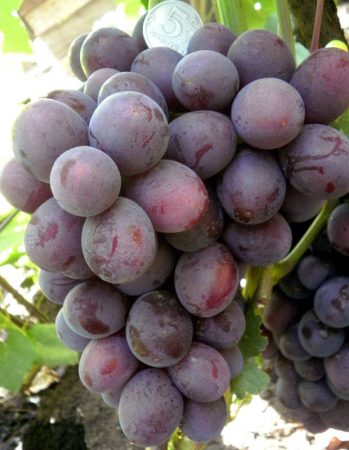 A respectable appearance and great taste are the merits of the Joni hybrid, bred as a result of crossing the Cardinal and the Talisman.
A respectable appearance and great taste are the merits of the Joni hybrid, bred as a result of crossing the Cardinal and the Talisman.
On tall shoots, broad, slightly loose clusters with dark pink berries form. The weight of the berries is 12-15 grams, the clusters are 1000-1200 grams. Peduncles bisexual, light pollination, the vine ripens evenly. No brushing is observed in the brush.
The taste of berries is sweet, with a subtle aroma of nutmeg. The pulp is juicy, sprinkles with juice. The species is frost-resistant, not susceptible to fungal infections, it gives ovaries in stepsons. Due to the increased load in general, additional fertilizing is given to the plant.
The crop keeps well on the vine without losing sugar content.
Disadvantages: with insufficient care, it is affected by mildew; in rainy summers, peas appear in a bunch.
Dawn of Light
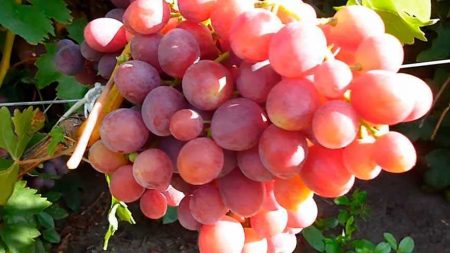 High commercial properties stand out hybrid Zarya Nesveta. Heat-loving, the best results were shown in the Don region, in the Caucasus.
High commercial properties stand out hybrid Zarya Nesveta. Heat-loving, the best results were shown in the Don region, in the Caucasus.
Maternal couple - varieties Talisman, Cardinal. Harvested early, after 100-105 days. Shoots are powerful, with a strong skeleton, a large growth force. Fertility of the vine is high, up to 3 brushes.
Grones are large, with oval, sometimes spherical grapes. Weight on average - 700-800 grams, with proper care grow up to 1.8-2 kg. The color of the shell changes, first pinkish, then, as it ripens, it turns purple. Berries weigh about 13-15 grams. The taste is excellent, with an original strawberry note.
G.f is appreciated for good berry picking rates (22-25 kg per bush), frost resistance. Not prone to peeling, suitable for transportation. Other characteristics of the species are being investigated: disease resistance, adaptation in different climatic regions. Planting material is well rooted, shelter is required for the winter.
The disadvantages of the hybrid:
- does not tolerate heat;
- prone to overloading the vine (requires the formation of grones)
- prone to attack by birds.
Grown in private farms, grape breeders.
Marshmallows
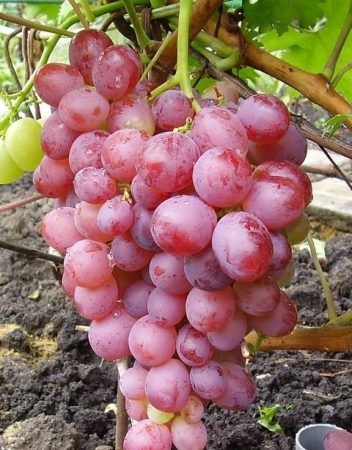 An interesting hybrid with unusual coloring berries. From parents - Roadside and Mascot, the hybrid received protection against fungal infections, a harmonious taste.
An interesting hybrid with unusual coloring berries. From parents - Roadside and Mascot, the hybrid received protection against fungal infections, a harmonious taste.
Shoots grow quickly, form strong bushes. Cuttings ripen well. The flowers are bisexual, additional pollination is not required. The clusters are large, 600-700 grams, high density. Gardeners note a beautiful type of berries - oval, purple-red. Berries weigh about 12-15 grams. The peel is tender, with a barely visible plaque, when eating fresh fruits is completely not felt. The pulp with a crunch, dense, pleasant taste.
Grapes ripen early (100-110 days), the berry for a long time collects sugar, while not falling off the bush. They are in no hurry with cleaning, the clusters are kept until the colds. They don’t lose their shape, there is no outrage, no peeling.
On a note!
In heavy rains, some berries crack.
The hybrid is well rooted, the vine can withstand any load. According to the results of observations, rationing is not required.
Ayuta
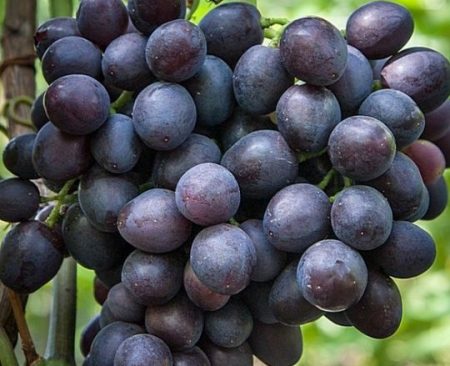 Name of city received in honor of a small river Ayuta, flowing in the Rostov region. Maternal couple - Cardinal steady and Rosanna.
Name of city received in honor of a small river Ayuta, flowing in the Rostov region. Maternal couple - Cardinal steady and Rosanna.
The berries are crisp, tasty, with a rich aftertaste. The shell is thin, with purine bloom, strong, it is not felt when eating. The weight of a beautiful, conical-shaped fruit reaches 12 grams. Grones are large, at 700-1000 grams, of medium density.
Bushes of rapid growth, the vine ripens by the end of July or early August (95-105 days). Peduncles bisexual, velvet.
The collection is complicated by the strength of the comb, the brushes are cut with secateurs. Frost resistance - up to -24ºC, in the middle lane for the winter they must be covered. It gives the best results in the southern regions.
In the process of variety testing, no lesions by diseases, pests were revealed. As the vines grow, fruitfulness increases.
Ozone
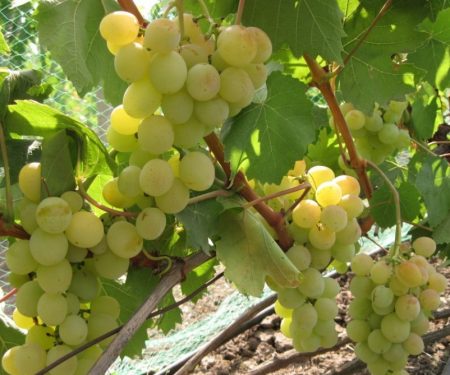 In the collection of E. Pavlovsky hybrids from one maternal pair, but differing in characteristics, are bred. Ozone grapes, like the Ali Baba hybrid, have only parents, but they do not look like a "relative".
In the collection of E. Pavlovsky hybrids from one maternal pair, but differing in characteristics, are bred. Ozone grapes, like the Ali Baba hybrid, have only parents, but they do not look like a "relative".
The clusters are large, attractive in appearance, reaching 1.4 kg. Conical berries, weighing 10-12 grams. The color of the skin and pulp is white, transparent. The taste is unremarkable, simple but pleasant.
The vine is strong, fast growing. Forms grones evenly; load rating on bushes is required. Irrigation is not peculiar. The hybrid has a high sugar accumulation. Resistant to most infections.
Romeo
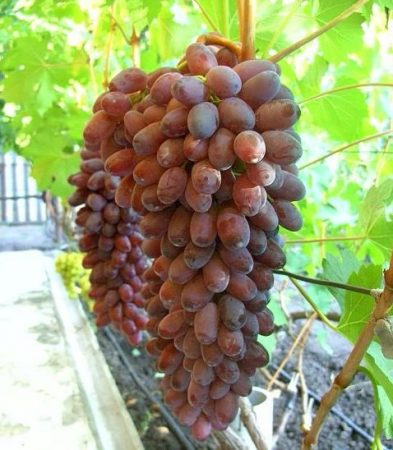 The form stands out among other species by maturity. Harvest from Romeo vines harvested not earlier than the beginning of September (mid-late grapes).
The form stands out among other species by maturity. Harvest from Romeo vines harvested not earlier than the beginning of September (mid-late grapes).
Bushes quickly enter the fruiting stage, cuttings are well rooted. The clusters are large, up to 0.9-1 kg. Fruits are nipple, lilac, by weight - 16-18 grams. Taste without frills, harmonious, pleasant.
Peduncles bisexual, uniform ripening. There is no burning in the thrones. Advantages of Romeo:
- resistance to frost;
- little susceptible to fungal infections;
- high productivity.
A significant drawback noted by gardeners is their unsuitability for transportation. This should be considered when growing crops for sale.
Hummingbird
G.F. early-medium maturity, with vigorous shoots, bisexual peduncles. Transplanting pollinators is not required. High ripening and rooting of cuttings is noted.
Large vines, round-shaped berries weighing up to 15 grams are formed on the vine. The taste is ordinary, pleasant, there is no aroma of nutmeg. When harvesting, the berries do not burst, they do not crumble on the bushes. In terms of resistance to infections and freezing temperatures, tests are underway.
Beautiful girl
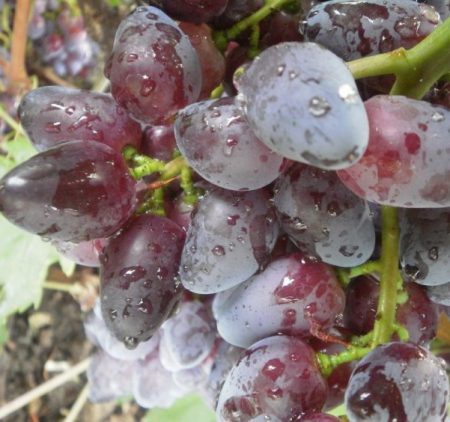 Medium-sized bushes of Beauty are strewn with dense tassels of pink-purple berries. The appearance of the plantings during the harvesting period is attractive: the clusters are elongated, weighing up to 1 kg and look very elegant.
Medium-sized bushes of Beauty are strewn with dense tassels of pink-purple berries. The appearance of the plantings during the harvesting period is attractive: the clusters are elongated, weighing up to 1 kg and look very elegant.
Amur vines are among the parental forms.
The culture is early, the ripening time is 110-115 days. Berries in neat egg-shaped grones with a refreshing taste. The shade of nutmeg and vanilla is felt.
Advantages:
- stable yield;
- lack of seeds in the berries;
- resistance to the bright rays of the sun;
- resistance to damage by gray rot, oidium.
They appreciate the variety for its excellent taste, early harvest.
Lelik
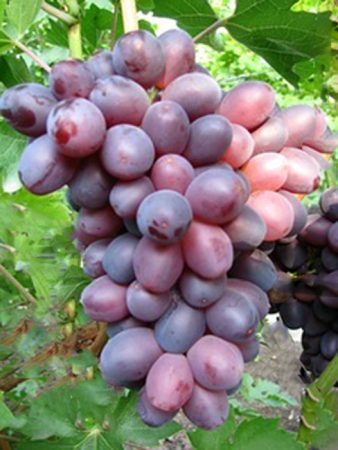 After crossing the table species of Baklanovsky early and Hybrid 41, grapes with the original name Lelik were obtained. Early, berries are picked in the early days of August (in southern Russia). Medium brushes, weighing up to 0.5 kg, moderate friability. Advantages:
After crossing the table species of Baklanovsky early and Hybrid 41, grapes with the original name Lelik were obtained. Early, berries are picked in the early days of August (in southern Russia). Medium brushes, weighing up to 0.5 kg, moderate friability. Advantages:
- pleasant taste;
- good rooting of shoots;
- good frost resistance.
The berries do not fall, they hang on the bushes for a long time, but at the same time the fruits ripen unevenly in the brush and are painted in the main varietal color. Purpose: making juices, jams. In winemaking is not applicable.
Marlborough
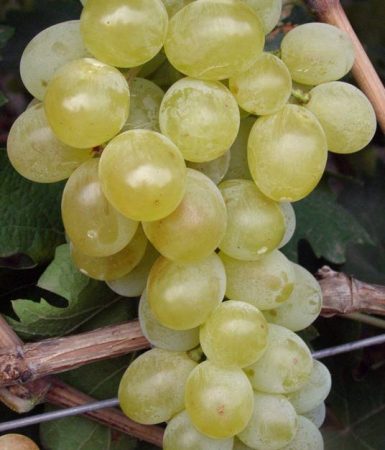 Super-early, vigorous hybrid. It stands out for good ripening of shoots. Peduncles bisexual.
Super-early, vigorous hybrid. It stands out for good ripening of shoots. Peduncles bisexual.
In beautiful clusters, an amber-colored berry is formed, each weighing 12 grams. The total weight on average is 600 grams. Appreciated for its light, with a subtle aroma of muscat, taste. The brushes are slightly loose, the berries ripen evenly.
It is susceptible to infection by some infections in some seasons, but due to the early ripening period this grape is practically not attacked by birds and wasps.
Master
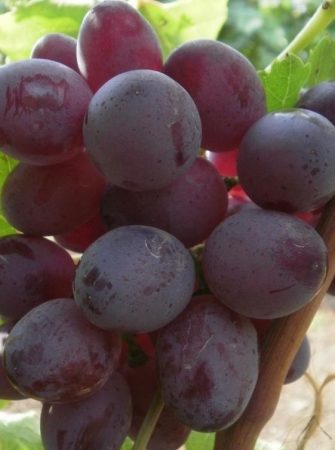 Harvest from the bushes Masters harvested in the first half of August. Fruiting throughout the vine is uniform, the brushes are powerful, not prone to peeling. Dark red oval berries, pleasant sweet taste. Weight - 10-12 grams. "Pros" of the hybrid:
Harvest from the bushes Masters harvested in the first half of August. Fruiting throughout the vine is uniform, the brushes are powerful, not prone to peeling. Dark red oval berries, pleasant sweet taste. Weight - 10-12 grams. "Pros" of the hybrid:
- early ripening;
- harmonious taste;
- universal purpose;
- uniform ripening and staining of fruits in the hands.
Berries do not crumble, they stay on bushes for a long time.
The variety is known for high frost resistance, is able to withstand up to minus 24 degrees without damage to the bush, but to maintain high productivity the plant is sheltered for the winter period. The master is recommended for growing novice growers, as unpretentious in care.
Maestro
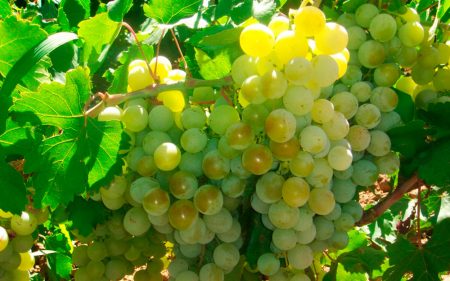 Included in the group of dining hybrid forms, early ripe, with tall bushes. The flowers are bisexual, pollinated without much difficulty.
Included in the group of dining hybrid forms, early ripe, with tall bushes. The flowers are bisexual, pollinated without much difficulty.
Bunches without peas, large, moderately loose. Weight on average - 600 grams, but with good care gives grapes up to 800-900 grams. The upper part of the brush is similar to a cylinder, below it goes into a cone. The berries are white, with juicy pulp, oval in shape. By weight - about 10-12 grams.
The maestro is often used for holiday treats, as white berries look original on banquet tables.
Resistance to diseases is average, withstands cooling to minus 23ºC.
Monarch
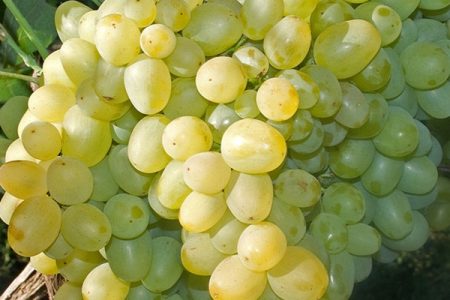 Belongs to the group of medium grape varieties, brush weight - up to 1 kg. The shape of the gron is conical. The berries are large, from 15 to 30 grams, look like cream.
Belongs to the group of medium grape varieties, brush weight - up to 1 kg. The shape of the gron is conical. The berries are large, from 15 to 30 grams, look like cream.
Maturing term - 125-140 days.Features: high sugar content in pulp, stable yield indicators (7-8 kg of ripe berries from the bush).
Modern
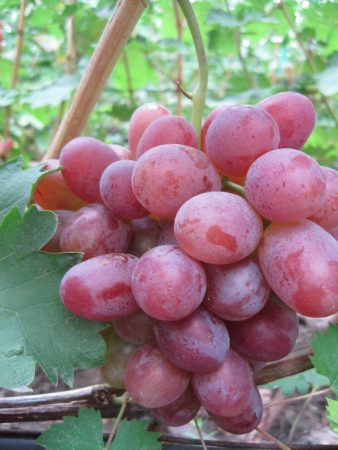 By the end of August, in the south, the brushes of Modern grapes ripen. Has bisexual peduncles, large dense brushes.
By the end of August, in the south, the brushes of Modern grapes ripen. Has bisexual peduncles, large dense brushes.
Grapes rounded balls, purple-red color. The form is not prone to peeling, cracking. The pulp contains from 3 to 6 seeds. The taste is sweet and sour, pleasant. Sugar content is 20-21%, but sweetness depends on care and proper watering.
The main characteristics are checked during variety tests in different climatic zones
Muscat Novoshakhtinsky
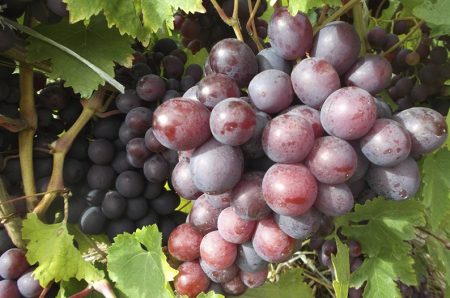 Grown by breeders and amateurs, appreciated for the rapid maturation of the vine, resistance to adverse weather conditions.
Grown by breeders and amateurs, appreciated for the rapid maturation of the vine, resistance to adverse weather conditions.
Cuttings root quickly, prefer heavy soils. It is resistant to the main diseases of the culture, the berries do not get sick even with leaf damage. Grones weigh up to 0.5 kg and mature in mid-August. The color of the berry is red with a purple tint, 2-3 seeds inside. The pulp is juicy, crunches when eating. The peak of fruiting and the opening of the whole bouquet of taste occurs in the vines of the second year of life.
Berries are used for the production of dessert wines; sugar concentration reaches 18%. Hybrid is appreciated for its resistance to low temperatures (up to minus 24 degrees), productivity, excellent taste of berries. For winter, shelter in the middle lane is not required.
In memory of the surgeon
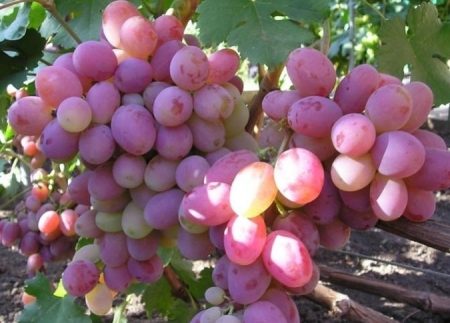 A pair of parents of the hybrid - varieties Talisman, Nist Ripening early, 110-115 days. Aging of the vine reaches 80%. Peduncles of hermaphroditic type. Beautiful brushes grow in weight up to 700-800 grams, in some cases up to 1 kg.
A pair of parents of the hybrid - varieties Talisman, Nist Ripening early, 110-115 days. Aging of the vine reaches 80%. Peduncles of hermaphroditic type. Beautiful brushes grow in weight up to 700-800 grams, in some cases up to 1 kg.
The fruits are oval, white-pink, sometimes pure pink. Weight - about 20 grams, juicy pulp, with a very good taste.
In memory of the teacher
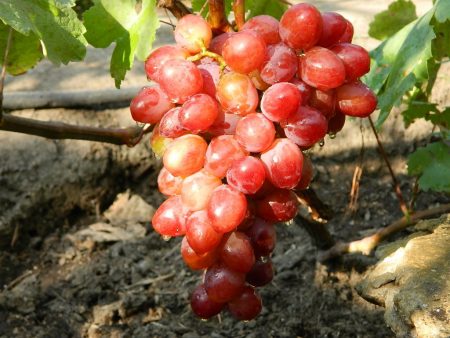 A vigorous vine gives large, strongly dissected leaves, fleshy brushes of berries. By weighty clusters, the hybrid of the Teacher's Memory is easy to recognize in the plantings.
A vigorous vine gives large, strongly dissected leaves, fleshy brushes of berries. By weighty clusters, the hybrid of the Teacher's Memory is easy to recognize in the plantings.
Weight - 1-1.5 kg, a large berry, oval in red or dark lilac color. The consistency is dense, the taste is delicate, slightly sweet, the aroma of nutmeg is felt. Sugar content - 20-21%.
Patrick
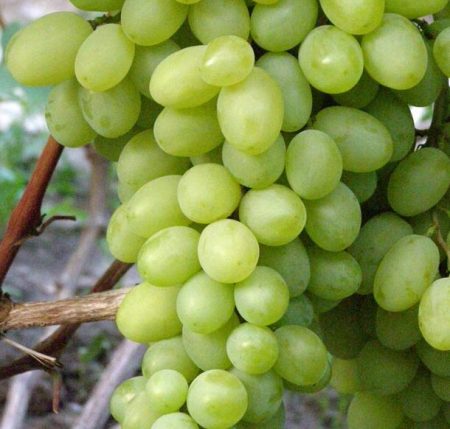 So far, a little-studied hybrid, mainly grown for testing by amateurs. Powerful, up to 1 kg of brushes are formed on vigorous bushes. The berries are oval, white, weight 10-15 grams.
So far, a little-studied hybrid, mainly grown for testing by amateurs. Powerful, up to 1 kg of brushes are formed on vigorous bushes. The berries are oval, white, weight 10-15 grams.
The taste is ordinary, sweetish. Shoots ripen well on rootstocks, the crop ripens early, in early August (southern Russia).
Beauty
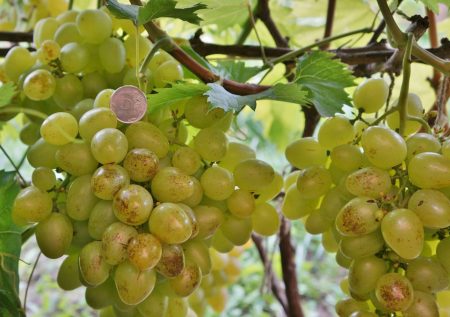 G.F. The charm was deduced not so long ago, features and potential are being studied by gardeners from different regions of the Russian Federation. Ripening dates are early (105-110 days), resistance to frost is noted. Recommended for cultivation in the middle lane.
G.F. The charm was deduced not so long ago, features and potential are being studied by gardeners from different regions of the Russian Federation. Ripening dates are early (105-110 days), resistance to frost is noted. Recommended for cultivation in the middle lane.
Distinctive features:
- good growth power;
- profuse bearing;
- excellent taste of berries.
Grones reach a weight of 800-900 grams, berries of the original yellow-green color. It tastes pleasant, juicy, with a pronounced aroma of nutmeg. When eating, a dense skin is not felt.
The rooting of the cuttings is good, when forming brushes, it is necessary to normalize the amount.
Producer
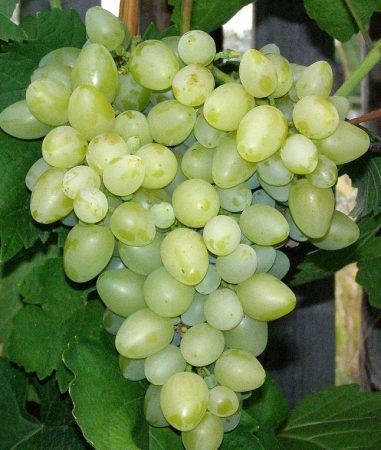 By mid-August, the hybrid form of grapes Producer will please the first berries. On the bushes, most shoots are fruitful, flower stalks are mainly female. Needs replanting pollinators.
By mid-August, the hybrid form of grapes Producer will please the first berries. On the bushes, most shoots are fruitful, flower stalks are mainly female. Needs replanting pollinators.
The brushes are elongated, slightly loose, with dense white-green berries. The weight of the fruit is 9-10 grams, the taste is pleasant. Basically, berries are used for fresh consumption, decoration of festive tables.
Advantages: stable yield, resistance to infections.
Rose Not Light
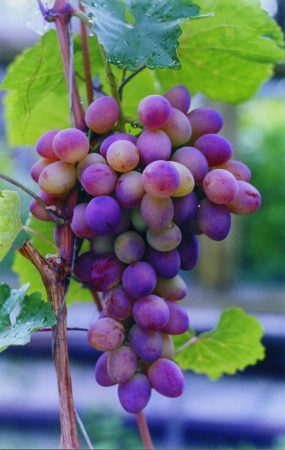 A hybrid with the original name matures early (95 days). It is distinguished by good ripening of shoots, little susceptible to disease (especially mildew).
A hybrid with the original name matures early (95 days). It is distinguished by good ripening of shoots, little susceptible to disease (especially mildew).
The clusters are beautiful, with oval, pink-colored berries. The average weight is 0.5 kg, the berries reach a weight of 8-9 grams. When chewing, a nutmeg aroma is felt. Not afraid of frosts, it feels quite normal with mild cooling. Recommended for cultivation in the south of the country.
Senator
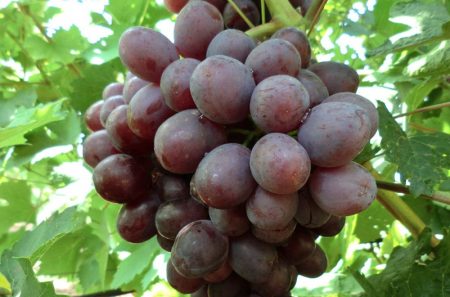 An excellent hybrid with bushes of good growth, a long powerful branched vine. The leaves are large, heavily indented.
An excellent hybrid with bushes of good growth, a long powerful branched vine. The leaves are large, heavily indented.
For pollination, replanting of other varieties is not required.
Large, up to 18 grams of berries, burgundy color are formed in the brush. The skin is dense, but it is not felt when eating. Inside - a pair of seeds. The flesh melts in the mouth, tender, juicy.
The first berry picking is at the end of August (in the south), but usually the Senator is picked in September.
"Pros":
- excellent taste;
- suitability for transportation;
- resistance to subzero temperatures (-24ºC);
- stable harvesting.
The vine is not susceptible to infections, attack by wasps, successfully hibernates in the middle lane with little shelter.
Senya
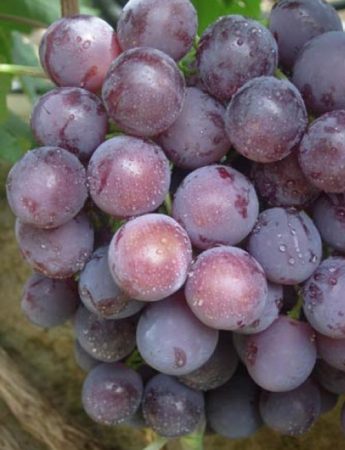 The first berries of Senya grapes ripen in 100-110 days, but they reach full sweetness later. Appreciated for its excellent taste, floral aftertaste.
The first berries of Senya grapes ripen in 100-110 days, but they reach full sweetness later. Appreciated for its excellent taste, floral aftertaste.
The advantages include:
- high commercial properties;
- suitability for transportation;
- high rooting of shoots.
On the bushes, the fruits stay for a long time, but are prone to sifting. Stepsons bear fruit well. Frost resistance up to minus 24ºC. Such indicators are characteristic of most types of Pavlovsky selection.
Super Extra
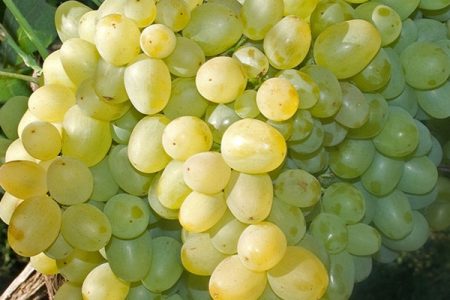 The presence in the name of the word "super" speaks for itself. An early hybrid, fast bearing, harvested from the first day of August.
The presence in the name of the word "super" speaks for itself. An early hybrid, fast bearing, harvested from the first day of August.
Powerful grones grow up to 500 grams, berries are uneven in size, juicy. Grapes with a dense shell, which eliminates the attack of wasps, and also contributes to the excellent transportation of the crop.
Super-Extra performed well in regions with a harsh climate (Ural, Siberian regions). Resistant to frost up to -25ºC, to the main infections of the culture.
Pharaoh
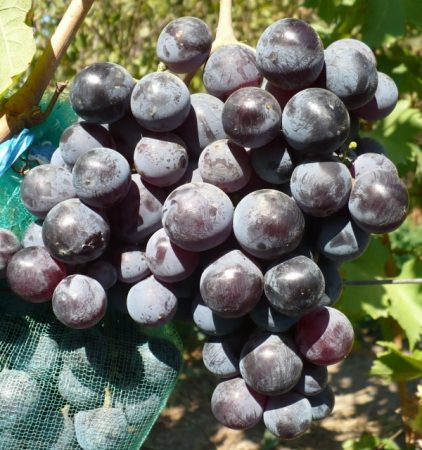 The hybrid has only recently been brought to the attention of winegrowers, and testing is ongoing on the main parameters. The growing season is 130 days. The type of flower is bisexual, the bushes are tall, withstand cold snap well up to minus 23 ° C. In regions with frosty winters, vine cover is required.
The hybrid has only recently been brought to the attention of winegrowers, and testing is ongoing on the main parameters. The growing season is 130 days. The type of flower is bisexual, the bushes are tall, withstand cold snap well up to minus 23 ° C. In regions with frosty winters, vine cover is required.
Large berries and beautiful clusters are the hallmarks of the variety. Thick, elegant brushes with rounded purple berries weighing about 12-15 grams. The taste is simple, without any aftertaste.
Farm
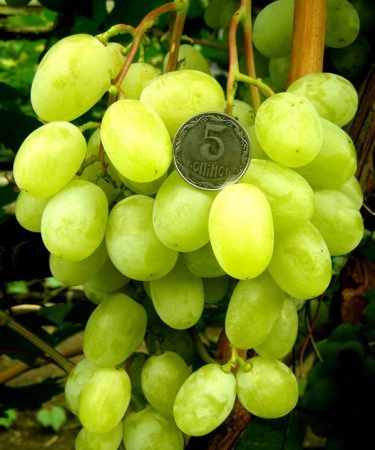 In the group of white grapes, the Khutorok form stands out. Medium brushes, with large oval berries reaching a weight of 15-16 grams. The taste is excellent, there is a pronounced aroma of nutmeg.
In the group of white grapes, the Khutorok form stands out. Medium brushes, with large oval berries reaching a weight of 15-16 grams. The taste is excellent, there is a pronounced aroma of nutmeg.
Harvested after 125 days, usually cultivated in the southern regions. Withstands frosts up to 22 degrees.
Charley
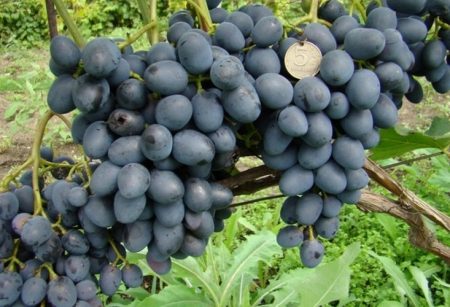 The hybrid is appreciated for 100% ripening of the vine, the ability to withstand a large load on the shoot (up to 6-7 brushes). Berries ripen after 115 days, but the sugar set lasts a long time. Fruit staining does not indicate full maturity.
The hybrid is appreciated for 100% ripening of the vine, the ability to withstand a large load on the shoot (up to 6-7 brushes). Berries ripen after 115 days, but the sugar set lasts a long time. Fruit staining does not indicate full maturity.
Conical brushes, weight - up to 900 grams. The berries are blue, with colorless flesh and juice. They grow up to 9 grams, the shape is in the form of an egg. Table grapes, but suitable for home winemaking.
Enigma
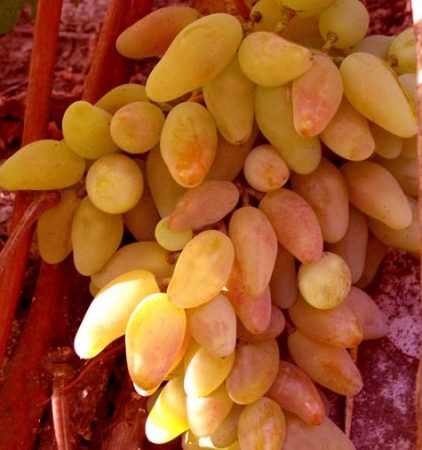 Malvina and Arcadia - the parent couple of the Enigma hybrid. It is famous for its unusual, slightly elongated shape and yellow-pink color of berries.
Malvina and Arcadia - the parent couple of the Enigma hybrid. It is famous for its unusual, slightly elongated shape and yellow-pink color of berries.
Weighty berries (15-16 grams) are sweet, juicy, with a peel covered in a spring. When ripening, a strong aroma of nutmeg is felt.
Harvested in the fall, in September, after about 130-135 days. It is imperative to normalize the number of grones on the vine so that the hands mature faster. The hybrid was introduced not so long ago, is under study.
Effect
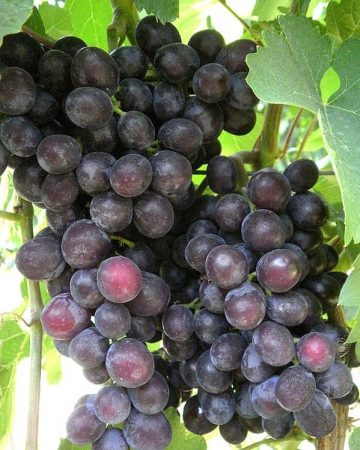 The hybrid is not yet as famous as its counterparts, but has already established itself as a frost-resistant and unpretentious variety. Advantages:
The hybrid is not yet as famous as its counterparts, but has already established itself as a frost-resistant and unpretentious variety. Advantages:
- immunity to frost;
- low susceptibility to fungal infections;
- great taste.
Early harvest (110 days), high pollination rates, ability to withstand heavy loads - these characteristics are noted by all who cultivated the Effect. The berries in the brush are large, 9-10 grams, red with an ink tint. Small peeling is noted; in unstable weather it has proved to be resistant to rot and cracking.
Anniversary 50
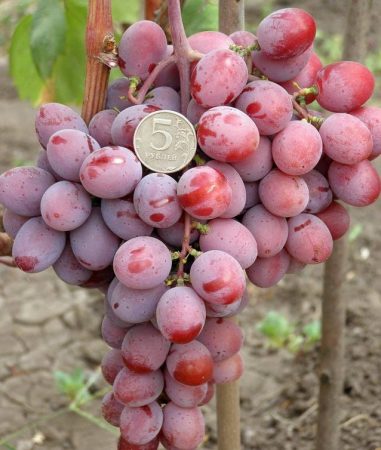 Also applies to the novelties of Pavlovsky selection, bred by selection work on varieties Kesha, Cardinal, Gift Zaporozhye.
Also applies to the novelties of Pavlovsky selection, bred by selection work on varieties Kesha, Cardinal, Gift Zaporozhye.
There is a study of the main characteristics, but already now there is a large brush, up to 1 kg, lack of crushing berries.
The fruits are beautiful, weighing 13-15 grams, dark red saturated color. The taste composition is harmonious, a sweet taste is felt. Ripens in the south by the 20th of August, in the Urals - at the end of September. Frost resistance is high.
Jaguar
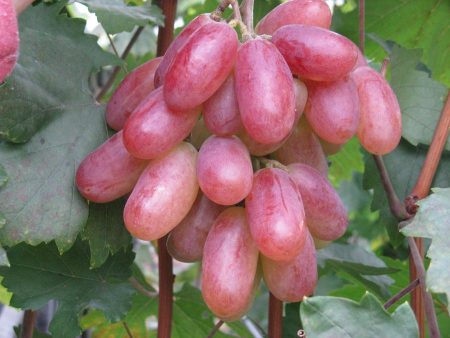 It was not by chance that the hybrid got such a name, since its ripening time is unusually fast - 104 days. Tall bushes give strong grones weighing about 1300-1500 grams. The taste is sweet-sour, pleasant.
It was not by chance that the hybrid got such a name, since its ripening time is unusually fast - 104 days. Tall bushes give strong grones weighing about 1300-1500 grams. The taste is sweet-sour, pleasant.
The weight of the berries is 14-16 grams. Brushes are not very dense, not prone to grinding. Hybrid of medium resistance to infections, the berries often crack.
Juliet
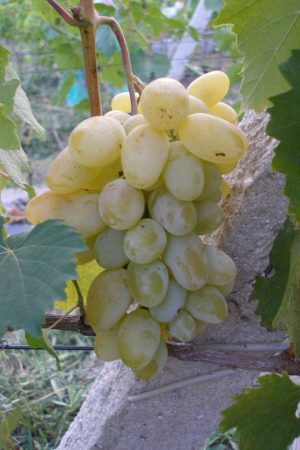 Included in a series of new hybrid forms, parents - varieties Demeter and Nist
Included in a series of new hybrid forms, parents - varieties Demeter and Nist
Early unpretentious grapes with peduncles hermaphrodites. Pollinators are not required. In the south, the crop is harvested in mid-August.
Conical brushes are friable. The berries are oval, tasty, 7-10 grams. Good rooting of cuttings is noted, according to the main parameters, a study is ongoing.
Carmen
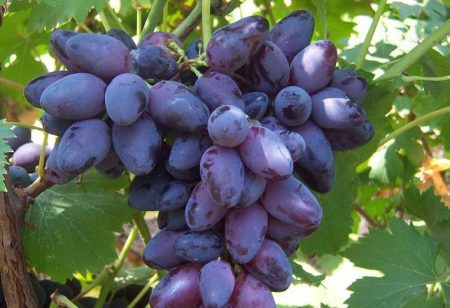 A variety well-known among winegrowers, it is valued for frost resistance (up to minus 30 degrees), productivity. From the bush with proper care, 5-6 kg of fruits are collected.
A variety well-known among winegrowers, it is valued for frost resistance (up to minus 30 degrees), productivity. From the bush with proper care, 5-6 kg of fruits are collected.
Bushes of high vigor, fruiting along the entire length of the shoot. The berries are large, up to 13-14 grams by weight. The density of the brushes is average, the weight is 500-700 grams.
To increase productivity, the number of grones on the vine is normalized.
Rochefort
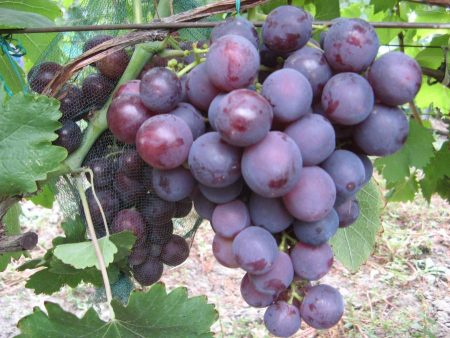 The fleshy juicy pulp of berries is famous for the hybrid form of Rochefort, presented by the breeder in 2002. The vine is strong, tall, reaches a length of 130-150 cm.
The fleshy juicy pulp of berries is famous for the hybrid form of Rochefort, presented by the breeder in 2002. The vine is strong, tall, reaches a length of 130-150 cm.
By the growing season - early grapes (110-115 days), fruiting is along the entire length of the shoot. Grones are weighty, up to 1 kg, the weight of berries is 12-14 grams.
The fruits are reddish, when ripe, almost black. Oval berries with a strong but not tough skin. The acid content is 4-5%, the sugar content is about 16-18%. Suitable for winemaking, good fresh.
They are not in a hurry with cleaning, the berries are held tightly on the vine, do not crumble. Over time, the taste becomes saturated, sweetness increases. 4-6 kg are removed from the bush.
Disadvantages:
- prone to shredding berries;
- affected by phylloxera (prophylaxis required);
- uneven coloring of berries.
With proper care, pathologies can be successfully avoided.
Hip-hop
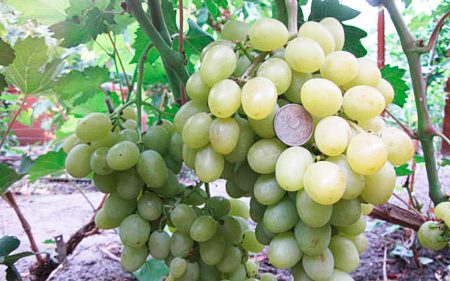 A hybrid variety, bred not so long ago, so most of the characteristics are checked. Vegetation is 110 days; in the south, Hip-Hop matures by the first days of August.
A hybrid variety, bred not so long ago, so most of the characteristics are checked. Vegetation is 110 days; in the south, Hip-Hop matures by the first days of August.
The vine is strong, the shoots ripen perfectly.
To obtain high-quality brushes, weak shoots are removed, vine wood is accumulated.
Peduncles are predominantly female type, pollination is successful even under adverse conditions. A medium-sized cluster, 500-600 grams, with the same vineyards. Color - yellowish or light green, weight 13-15 grams. Berries crunch when eating, run out of juice. The taste is simple, a muscat shade is weakly expressed. It is not of special interest for winemakers, but it is good in fresh form. It is suitable for transportation, retains its full taste and presentation.
The list of grape varieties grown by the hands of the talented enthusiast E.G. Pavlovsky, includes dozens of items. In some ways, the hybrid forms are similar, the use of the same maternal pairs affects. A number of hybrids are in variety testing, characteristics are checked to know exactly the required conditions for obtaining high yields.
Reviews
Ahmed, Kabardino-Balkaria
I grow Jaguar grapes for the fifth year. I am satisfied, although there are a lot of negative reviews on the forums. He came to the conclusion that he needed careful care and warmth. The first time was fruiting in the third year. Ripened by August 20. I was struck by a beautiful bright color of berries. Tasty, reminiscent of Asian varieties.
Elena, Rostov Region
Praising Variety Effect. Smart girl is easy! Of course, for our region the berry is too small, but in terms of productivity it breaks all records. The taste is on top, the clusters are gorgeous. The color is dark, the nutmeg taste is lovely! It does not rot, does not burst, and the wasp does not take it. Perhaps I’ll send for re-grafting to get a little larger berries.
Vlad, Kazakhstan
Conquered Zarya Nesveta, taste and productivity. Clusters are about a kilo, taste is nutmeg. A real delicacy really melts in your mouth. The brush hung for a long time on the bush for testing, but the taste did not change, it even became more saturated. The spring is small. The color of the berries is first burgundy, then began to turn into dark purple. Spent 4 treatments, there was no disease.




 Non-covering winter-hardy grape varieties for Moscow region
Non-covering winter-hardy grape varieties for Moscow region How to keep the vine in winter
How to keep the vine in winter When can I transfer grapes to another place in the fall
When can I transfer grapes to another place in the fall How to cover and prepare grapes for the winter in the suburbs
How to cover and prepare grapes for the winter in the suburbs